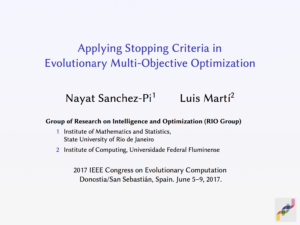The use of multi-objective evolutionary algorithms for solving black-box problems with multiple conflicting objectives has become an important research area. However, when no gradient information is available, the examination of formal convergence or optimality criteria is often impossible. Thus, sophisticated heuristic online stopping criteria (OSC) have recently become subject of intensive research.
Stopping criteria for evolutionary multi-objective optimization
Tutorials and slides

Applying Stopping Criteria in Evolutionary Multi-Objective Optimization
by Nayat Sanchez-Pi and Luis Martí
Tutorial presented at the 2017 IEEE Congress on Evolutionary Computation

Convergence Detection and Stopping Criteria for Evolutionary Multi-Objective Optimization
by Luis Martí and Nayat Sanchez-Pi
Tutorial presented at the 2015 IEEE Congress on Evolutionary Computation (doi: 10.13140/RG.2.1.4308.5926).

Convergence Detection and Stopping Criteria for Evolutionary Multi-Objective Optimization
by Luis Martí and Nayat Sanchez-Pi
Tutorial presented at the 2015 IEEE Congress on Evolutionary Computation (doi: 10.13140/RG.2.1.4308.5926).

EMO Stopping Criteria Detecting Stagnation in Multi–Objective Optimization
by Luis Martí
Mini course at the 5ª Escola Luso-Brasileira de Computação Evolutiva.
Laboratório Nacional de Computação Científica,
Petrópolis, Brazil; Feb. 18–21, 2014.
Software
We integrate the known approaches within the taxonomy and discuss them by extracting their building blocks. The formal structure of the taxonomy is used as basis for the implementation of a comprehensive MATLAB toolbox.
-
Wagner, T., Martí, L. (2010) Taxonomy-based Matlab framework for online stopping criteria.
A Python implementation of the current state of the art stop criteria. Can be used along DEAP and inspyred.
Reading list
This reading list contains papers that have to do with stopping criteria for evolutionary multi-objective optimization. Feel free to contribute to the list via the Mendeley group.
Failed refreshing OAuth2 access token: {"message":"Credentials are required to access this resource."}

